Jim Street Golden Sahara II
JIM STREET GOLDEN SAHARA II
Around 1956 Jim Street sets out to improve on the first version of his Iconic Golden Sahara dream Custom. Jim and his team created the legendary Laboratory on Wheels, the Golden Sahara II.
Special thanks to Jim Street for his stories on the car and how it was created.
[box_light]
(Special note; Jim Skonzakes and Jim Street are the same person. In the early 1960’s Jim Skonzakes officially changed his name from Skonzakes to Street hoping his new last name would be easier to spell for others)
[/box_light]
In Part One on Jim Street’s Golden Sahara we shared the story on how the accident that George Barris had with his personal 1953 Lincoln, eventually led to the creation of one of the best known Custom Cars in the world, the Golden Sahara. We also mentioned that the owner of the car, Jim Skonzakes (aka Jim Street) was not overall happy with the quality of the car. After showing the car around for some time Jim decided in 1956 that it was time to redo the things he did not care for, and add all the other features he had been dreaming about, but never had been able to incorporate into the first version of the Golden Sahara.
Jim also had not enjoyed that the first version of the Golden Sahara was created on the other side of the country from where he lived, which prevented him from having full control over the project. So this time around, the car would be build closer to his home in Dayton Ohio. Jim had planned the new version with his good friend Henry Meyer. Jim was a visionary guy with a photographic eye, and saw all things in his head before they were created. Henry was the engineer who could realize all of Jim’s wild ideas in three dimensions. Together they formed the perfect team for the job. Henry Meyer worked at a shop called Delphos Machine & Tool Co. in Dayton, Ohio.
 In 1956 Jim saw the double fins Bob Metz had created on a 1955 Buick, and decided that he wanted to have that feature on his Golden Sahara II as well. Jim had worked with Bob Metz before, and knew Bob would be the perfect guy to handle most of the body changed he had in mind. The rest of the job on the GS-II would be handled at the Delphos Machine & Tool shop in Dayton, Ohio.
In 1956 Jim saw the double fins Bob Metz had created on a 1955 Buick, and decided that he wanted to have that feature on his Golden Sahara II as well. Jim had worked with Bob Metz before, and knew Bob would be the perfect guy to handle most of the body changed he had in mind. The rest of the job on the GS-II would be handled at the Delphos Machine & Tool shop in Dayton, Ohio.
[divider]
Delphos Machine and Tool Co. frontman Ray Teague liked the idea to work on “things that can’t be done”. Delphos Machine engineer Henry Meyer had been accomplishing the “impossible” with race cars and other vehicles for many years. Similarly, Joe Rote electronic specialists, refuses to take “No” for an answer on any project and Bud West, an automobile painter of high repute on the local scene, turned his perfectionist eye on the problem when told: “You’ll NEVER make these pulverized Oriental fish scales into paint that will adhere to metal.” This team under guidance of Jim Street did wonders on the new version of the Golden Sahara. Ray’s younger brother Kenny Teague also assisted in a lot of the work on the Golden Sahara.
Jim Skonzakes’s plan for the new Golden Sahara was to create a functional car which combined show quality with all kind of state of the art electronic gadgets. This would created as Jim called it a “laboratory on wheels”. The end result would be something the car show audience would have never before seen in their live.

 This is how the Delphos Machine & Tool shop looks like in 2018. It is the shop where a lot of work on the Golden Sahara II was done around 1957-58.
This is how the Delphos Machine & Tool shop looks like in 2018. It is the shop where a lot of work on the Golden Sahara II was done around 1957-58.
[divider]
Building the Golden Sahara II
To make sure the Golden Sahara II would become Jim’s dream car he realized he had to deal with the project in a different way that how he did it with the first version of the car. Jim needed to be in control at all time. And the best way to do it was to start creating many design sketches of the ideas he had in his mind for so many years. The old Lincoln frame, which was still bend from the accident, was removed and replace by a stretched FoMoCo frame found at a local junkyard.
Many Changes needed to be made to the chassis and suspension to allow for all the state of the art electronic features Jim had planned. Jim wanted to hide as many of the electronic components as possible and to be able to do this a double floor was constructed. When it was time for the body modifications, Jim took the car to Bob Metz‘s Custom Shop in Shelbyville, Indiana. Jim had known Bob for many years and had relied on his handy work on several older project. Bob created new body panels for about half of the car, and modified most of the rest.
 An rare early image of the Golden Sahara, before the rear portion of the top was added.
An rare early image of the Golden Sahara, before the rear portion of the top was added.
[divider]
The original rear fender scoop design from the GS-I would remain on the second version, but the rest of the rear fenders was reshaped with a double fin by Bob Metz, Henry Meyer created a set of hand-made taillights (formed in the kitchen oven) to be fitted to them. The front fenders were reshaped with a new added panel that would create a functional scoop on top of the headlights and that would flow into the front fender character line. At the doors, this character line was also reshaped and now curved down to the bottom of the body, creating a cove. This cove would later be filled with a shaped steel insert fitted with many gold plated 1957 Chrysler radio push button ornaments. One of these “ornaments” was used as a push button to open the car’s doors.
New quad headlight where created. A set of frosted Plexiglass sheets with gold plated “G” and “S” monograms added to them, were used as covers. Below the headlights, bullet-shaped housings cover the electronic eyes that would automatically brake the car when needed. This was all set on gold plated mesh and set in a reshaped and extended headlight opening. The grille shape design remained very similar to the GSI version. The hood on the original version was rather poorly done and rather thin making it to flex when opened. So this time the shape was modified and round bar stock was added to make the new hood much stiffer, and a new smaller than before scoop was added to the front. At this time the body was put in primer and the team started to concentrate on the details. Jim considered the 1955 FoMoCo wrap around windshield too old for the updated car, and nothing from a production car would fit his ideas. Jim designed a new windshield as well as a much larger bubble rear window … next problem… how to create it for the car.
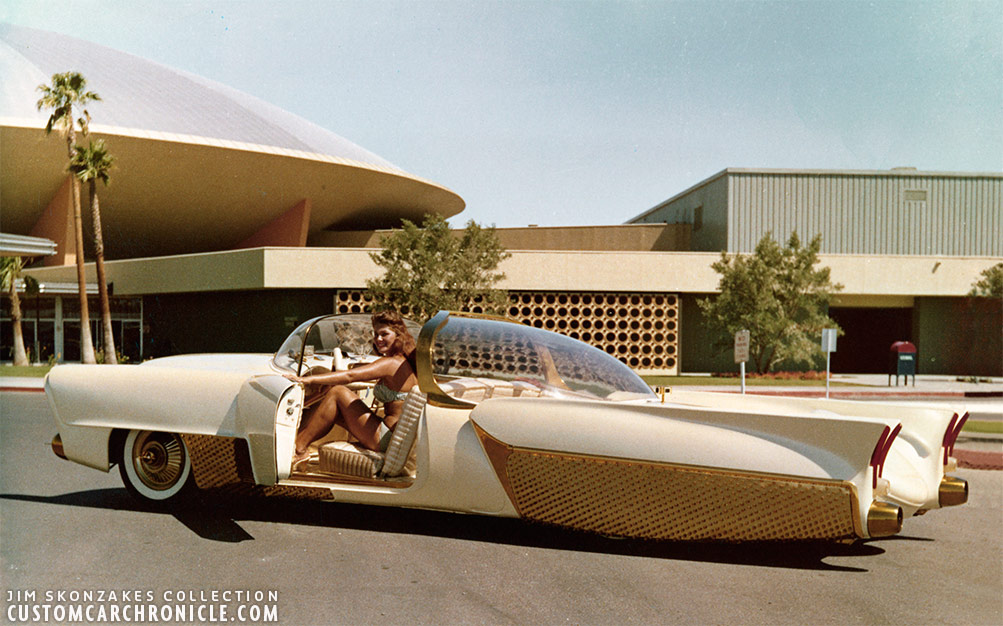 Miss Arizona (in the late 1950’s) Joanne Adams posing with the Golden Sahara II at the Las Vegas Convention Center.
Miss Arizona (in the late 1950’s) Joanne Adams posing with the Golden Sahara II at the Las Vegas Convention Center.
[divider]
 During one trip to California in 1959 Jim took his Golden Cobra with him as well. He took it to Eddie Martinez for an alligator type black vinyl upholstery job. On the way back they stopped at Lake mead for some time off and met there with George Barris for a Photo shoot. George wanted to shoot the GS with the boat behind it, so it was set up like that. This photo shows that there was never a hitch on the GS, it was just faked for the photo shoot. The Cobra Boat and trailer were still part of Jim’s Collection and will auctioned at the Jim Street Estate Collection Mecum Auction.
During one trip to California in 1959 Jim took his Golden Cobra with him as well. He took it to Eddie Martinez for an alligator type black vinyl upholstery job. On the way back they stopped at Lake mead for some time off and met there with George Barris for a Photo shoot. George wanted to shoot the GS with the boat behind it, so it was set up like that. This photo shows that there was never a hitch on the GS, it was just faked for the photo shoot. The Cobra Boat and trailer were still part of Jim’s Collection and will auctioned at the Jim Street Estate Collection Mecum Auction.
[divider]
The shape for the windows was created by building a metal frame to fit the cars interior. This was covered with chicken wire, this wire mesh was covered with plaster and sanded till the perfect shape was created. This mold was carefully removed from the car and used to create new Plexiglass windows. The very expensive plexiglass sheets were heated in a huge oven and shaped over the plaster dies. Not an easy thing to do, and it took them several tries to make it work. All this was something nobody had done before at the time. The shaped plexiglass pieces were place on the new Golden Sahara body and marked where the overlap material needed to be cut, and then this was very carefully removed and the glass shaped to fit the body perfectly, and the needed channels and rubber molding where created as well.
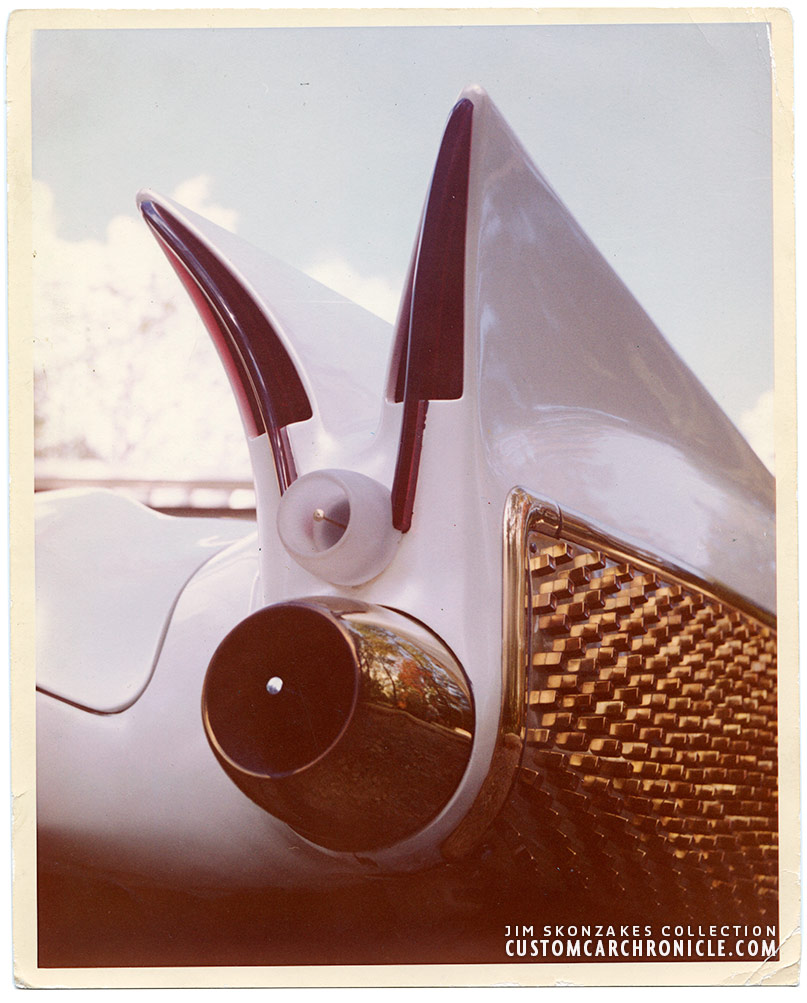 Close up of the Bob Metz created double finned rear fenders. Henry Meyer hand made the taillights and the ornaments on the rear fender skirt are 1957 Chrysler radio push buttons.
Close up of the Bob Metz created double finned rear fenders. Henry Meyer hand made the taillights and the ornaments on the rear fender skirt are 1957 Chrysler radio push buttons.
[divider]
Jim designed a new V-shaped “roll-bar” that Henry created with a solid piece of shaped metal as base. The bar itself was cut, shaped and welded by Henry, while Jim assisted with cold wet rags to prevent the metal from warping, later this was metal finished till it was perfect for the gold plating. Jim also made a Plexiglass top section to be fitted in between the windshield and the roll bar, but once finished he barely used it. “The car just looked so much better without it”.
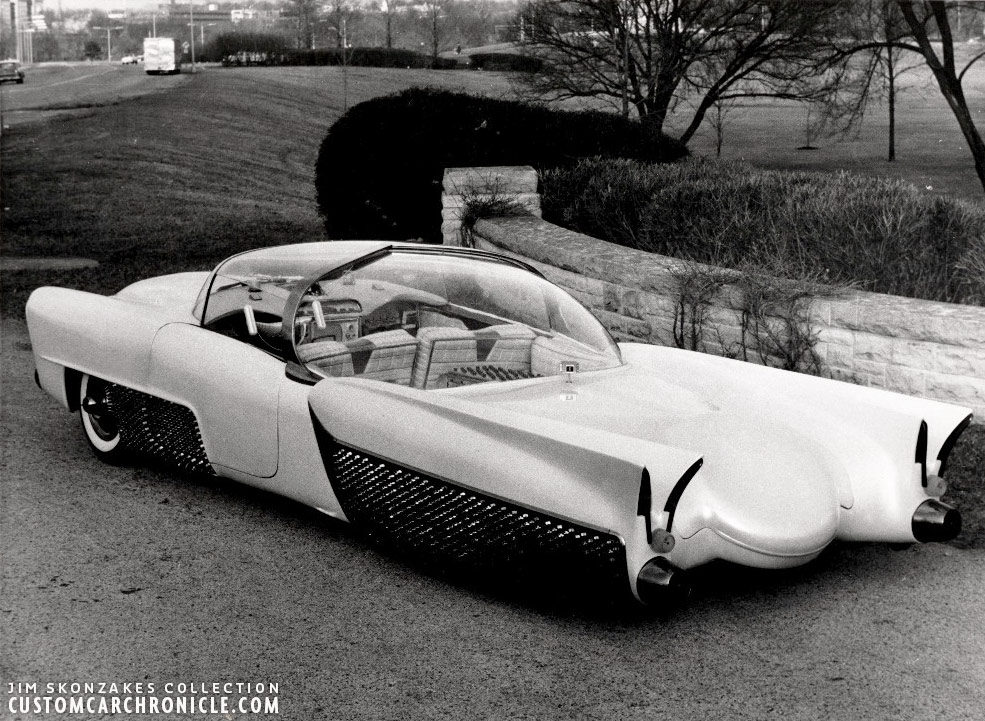 A rare photo of the Golden Sahara II with the Plexiglass top section in place. (photo courtesy of Jim Street Collection/Mecum/Rodder’s Journal)
A rare photo of the Golden Sahara II with the Plexiglass top section in place. (photo courtesy of Jim Street Collection/Mecum/Rodder’s Journal)
[divider]
During the process on the car Jim often wondered about the color and paint type he would use for the car. It needed to be something special. Jim had found a fake pearl necklace in a dollar store and he really like the pearl finish on them. After a lot of experimenting Jim was able to create his own unique pearl paint, and Bud West was responsible for painting the pearl mixture over refrigerator white and created the amazing finish. People who saw this car in the 1950’s and 60’s mentioned the paint was “out of this world”, Something they had never sen before. I have been told that these old pearl paints, as used on the GS-II had a completely different look and feel than the modern pearl paints. More on the Pearl Paint on the Golden Sahara II can be read in this CCC-Article
 Jim wanted to have single stick drive in the GS-II and asked if Henry Meyer could create it. Henry came up with two ways to do it and they picked what they thought was the best way, and it came out working perfectly. Then the electronics guy Joe Rote said that he could do a voice control system for the car, (remember this is in 1958) which even impressed Henry Meyer.
Jim wanted to have single stick drive in the GS-II and asked if Henry Meyer could create it. Henry came up with two ways to do it and they picked what they thought was the best way, and it came out working perfectly. Then the electronics guy Joe Rote said that he could do a voice control system for the car, (remember this is in 1958) which even impressed Henry Meyer.
[divider]
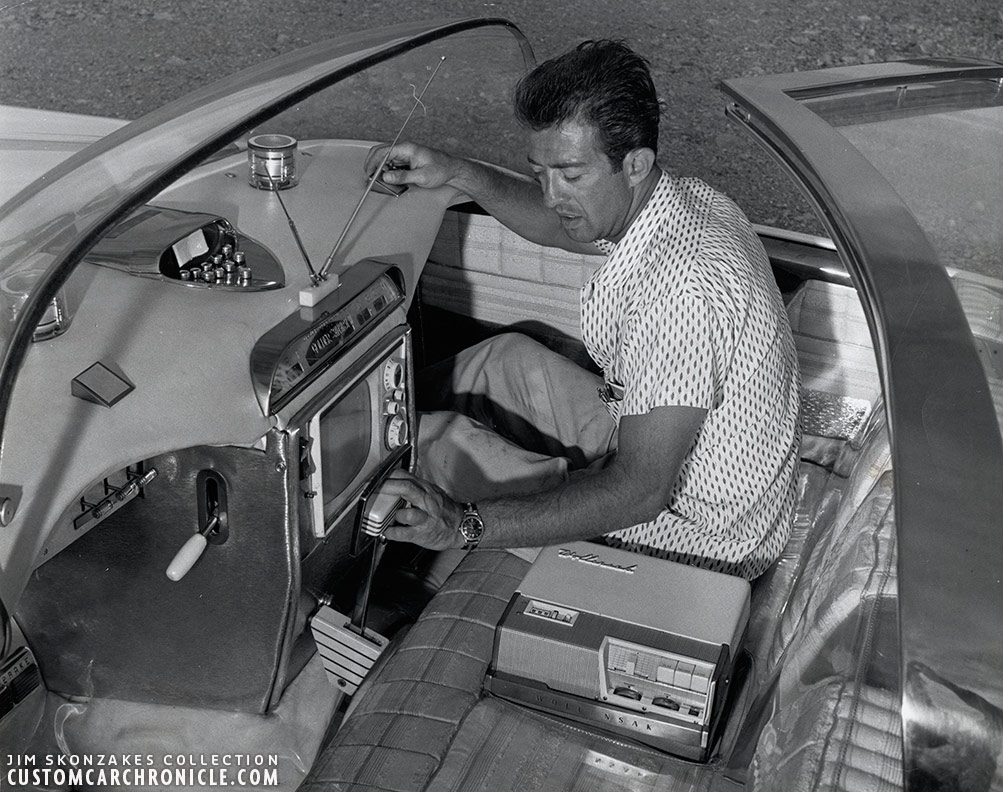 Jim demonstrating how the lever could be used to steer the car, but also as accelerator and brake. Notice the steering wheel had been removed to make this demonstration even more dramatic.
Jim demonstrating how the lever could be used to steer the car, but also as accelerator and brake. Notice the steering wheel had been removed to make this demonstration even more dramatic.
[divider]
Jim also had many new plans for the interior of the Golden Sahara II. The dash was heavily modified to fit the new style of the car, and to house all the controls needed for the new electronic features. At the top center of the new dash, Jim installed a 1958 Ford hood scoop ornament to house some of the controls. The steering wheel was created from a cut down 1957 Chrysler Imperial. This steering wheel was just one of the multiple ways to steer (five!). There was also a center control joystick, made from gold plated rod with a brass base and topped with a laminated shaped plastic knob. This rod could steer the car, but also acted as the accelerator and brake. Then there was a push button steering on either side of the dash, and also a voice control unit to steer the car. And yet another method was a complete remote control unit that you could use to steer as well as control everything else in the car. One of the features of the car was that it would automatically stop if an object came to close to the front of the car.
 A good look at the bubble top that was created for the Golden Sahara II. Bob Settles Melrose fabrications in Dayton Ohio was hired to made the plexiglass windows over the chicken wire and plaster molds Jim had created. The company could not get it right, so in the end Jim and Henry had to create the bubbles them selves.
A good look at the bubble top that was created for the Golden Sahara II. Bob Settles Melrose fabrications in Dayton Ohio was hired to made the plexiglass windows over the chicken wire and plaster molds Jim had created. The company could not get it right, so in the end Jim and Henry had to create the bubbles them selves.
[divider]
The interior also had a TV, a telephone, 8-track recorder, and special massage units inside the seats. The trunk of the car was loaded with electronic control systems and batteries needed for all the electronic features as we can see in one of the photos. You have to remember that this car was built in the later part of the 1950’s, before anyone had ever heard of transistors or printed circuits, let alone Silicon or microchips. It was all done with hand soldered chassis and vacuum tubes – bulky and heavy. The interior for the car was done by a guy in Indianapolis. Sadly Jim forgot the name of the guy. Henry Meyer knew his work, since this guy also did a lot of work on the interiors of the Indy cars. Jim had found the upholstery material that had gold colored wire woven into it. The material was fantastic back then, and even today, it is amazing. To protect the interior Jim had special plastic covers custom made, those covers are still on the car today in 2018. The total cost for this version of the Golden Sahara was estimated to be over $75,000. A substantial amount of money now, but an incredible amount in 1959, when the car was finished.
From the day the Golden Sahara debuted back in 1954 up until today, the car has amazed and inspired many people all around the globe. The cars design and technical features have been incorporated into many cars created since. And several Custom builders have created vehicles that were inspired by the looks of the Golden Sahara. More on that in a later article on the Custom Car Chronicle.
 The later version of the Golden Sahara had transparent Good-Year tires and illuminating custom hubs on handmade, by Bob Metz, hubcaps that weighted 20 pounds each.
The later version of the Golden Sahara had transparent Good-Year tires and illuminating custom hubs on handmade, by Bob Metz, hubcaps that weighted 20 pounds each.
[divider]
 A good look at all the electronics that were needed to control the car. No place for groceries here.
A good look at all the electronics that were needed to control the car. No place for groceries here.
[divider]
 Close up for a better look.
Close up for a better look.
[divider]
Dealer Displays
When show promoters heard about the GS-II and how many people it attracted Jim was invited to many shows and even offered money to bring his car to the shows. Besides doing the shows Jim promoted the car any way he could, including magazine ads, and which turned out to be very lucrative displaying it at new car dealers. The car always drew a crowd, and because the car was so far ahead of its time it would remain “new” year after year.The dealer owners knew how to draw a crowd with the car. They advertised the display of the car at the local papers, and then placed the car in the showroom for everybody to see. The car sales during these displays went up a lot. People were very inspired to buy the latest car after seeing the Golden Sahara II.
 Some of the special flyers created to promote the Golden Sahara at car dealers.
Some of the special flyers created to promote the Golden Sahara at car dealers.
[divider]
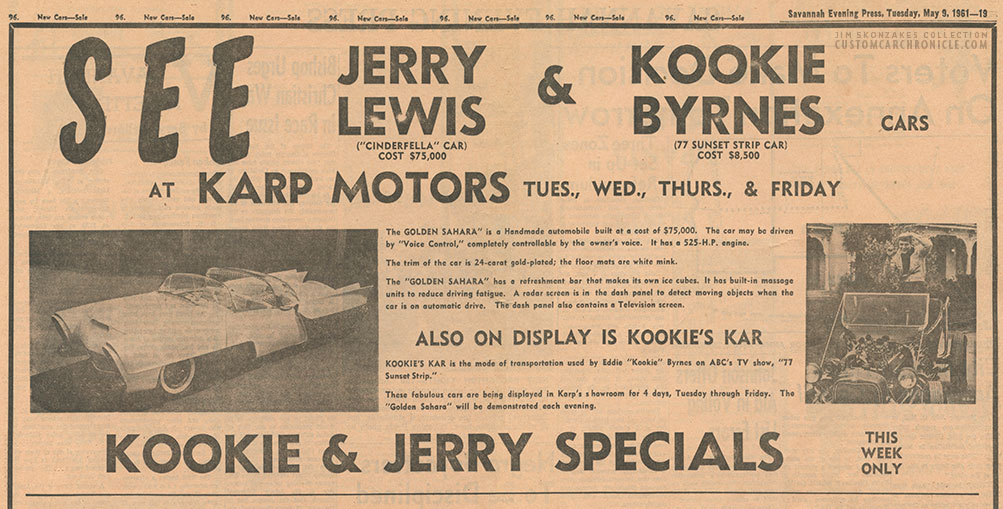 Jim saved as many news paper ads and articles as he could find. This is just one of the promotional ads from a car dealer who was going to have the Golden Sahara II and the Kookie T on display.
Jim saved as many news paper ads and articles as he could find. This is just one of the promotional ads from a car dealer who was going to have the Golden Sahara II and the Kookie T on display.
[divider]
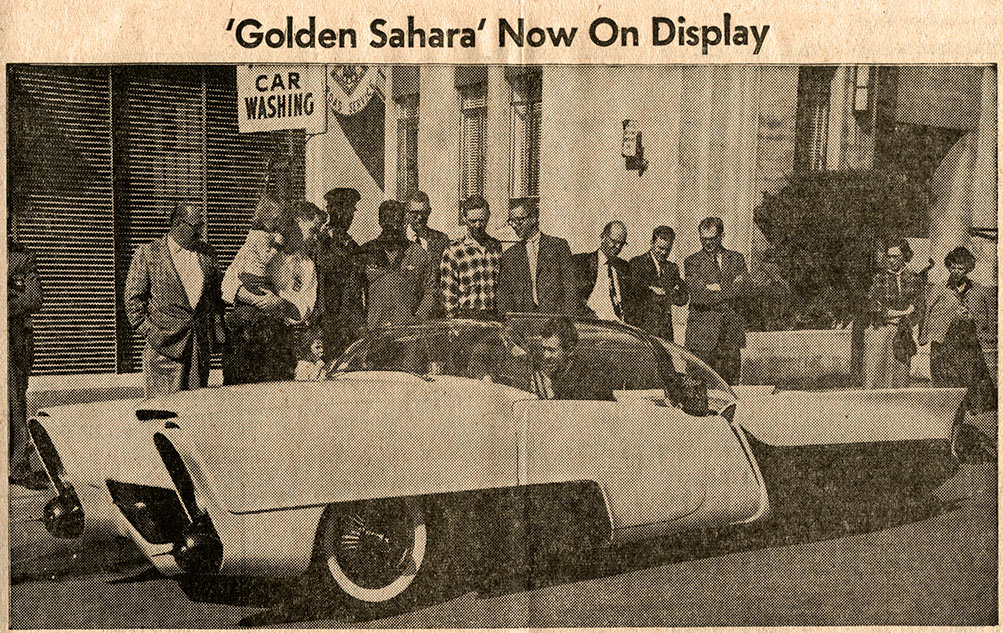 On the GS the front fenders where so low that the overhang almost acted like fender skirts. To be able to turn the front wheels the wheels had to be offset to the inside. The wheel centers where cut out and placed further out wards, this way the tires would fit closer to the center of the car, all that was needed to be able to steer the car.
On the GS the front fenders where so low that the overhang almost acted like fender skirts. To be able to turn the front wheels the wheels had to be offset to the inside. The wheel centers where cut out and placed further out wards, this way the tires would fit closer to the center of the car, all that was needed to be able to steer the car.
[divider]
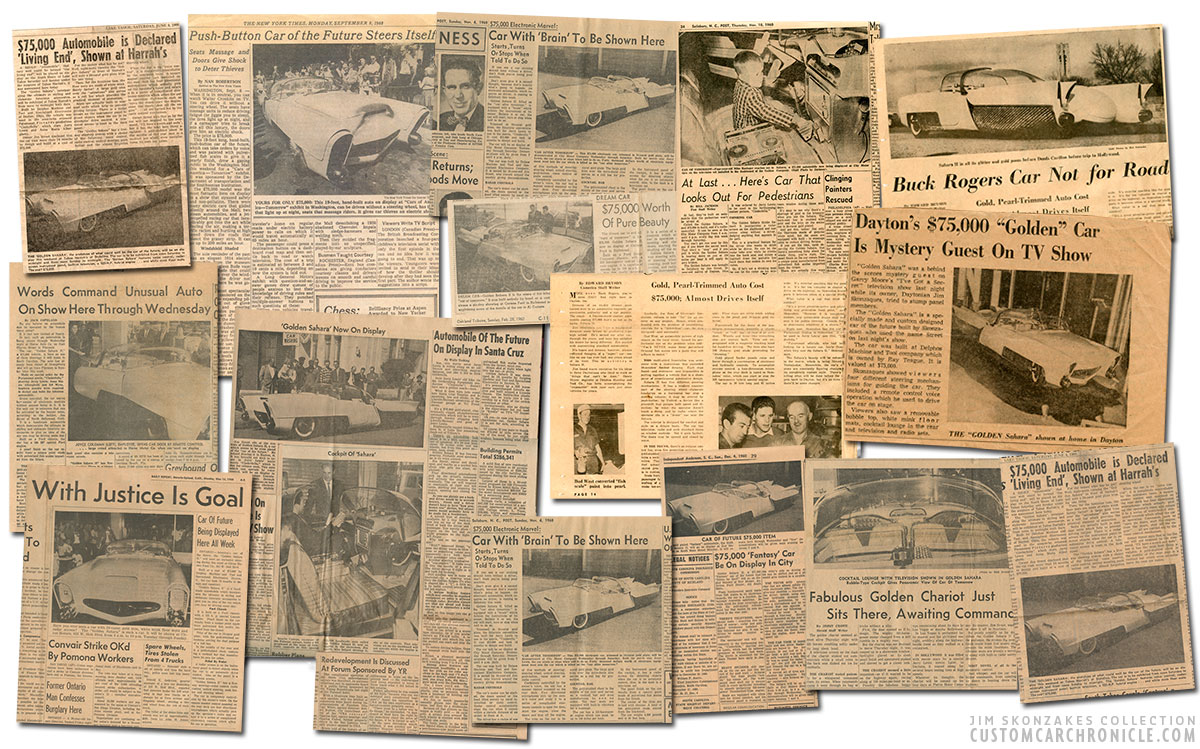 Just a few of the many newspaper articles devoted to the Golden Sahara II from all around the US. At nearly every town that had the Golden Sahara on display the local newspaper would write a story on the car.
Just a few of the many newspaper articles devoted to the Golden Sahara II from all around the US. At nearly every town that had the Golden Sahara on display the local newspaper would write a story on the car.
[divider]
 The dealers used the Golden Sahara to promote their business, but also as backdrop for other promotional photos.
The dealers used the Golden Sahara to promote their business, but also as backdrop for other promotional photos.
[divider]
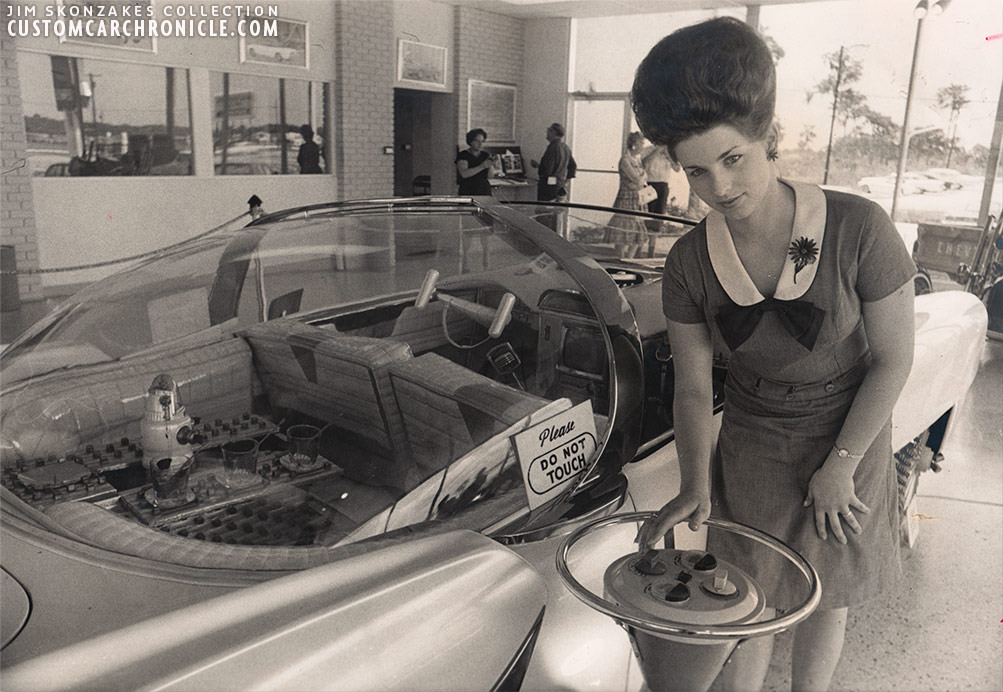 One of the dealer employees demonstrating the remote control unit Jim had later developed for the last version of the Golden Sahara. If you look careful you can see the Kookie-T on the far right of the photo, and its seat on the window reflection on the left.
One of the dealer employees demonstrating the remote control unit Jim had later developed for the last version of the Golden Sahara. If you look careful you can see the Kookie-T on the far right of the photo, and its seat on the window reflection on the left.
[divider]
 The Golden Sahara at yet another car dealer showroom.
The Golden Sahara at yet another car dealer showroom.
[divider]
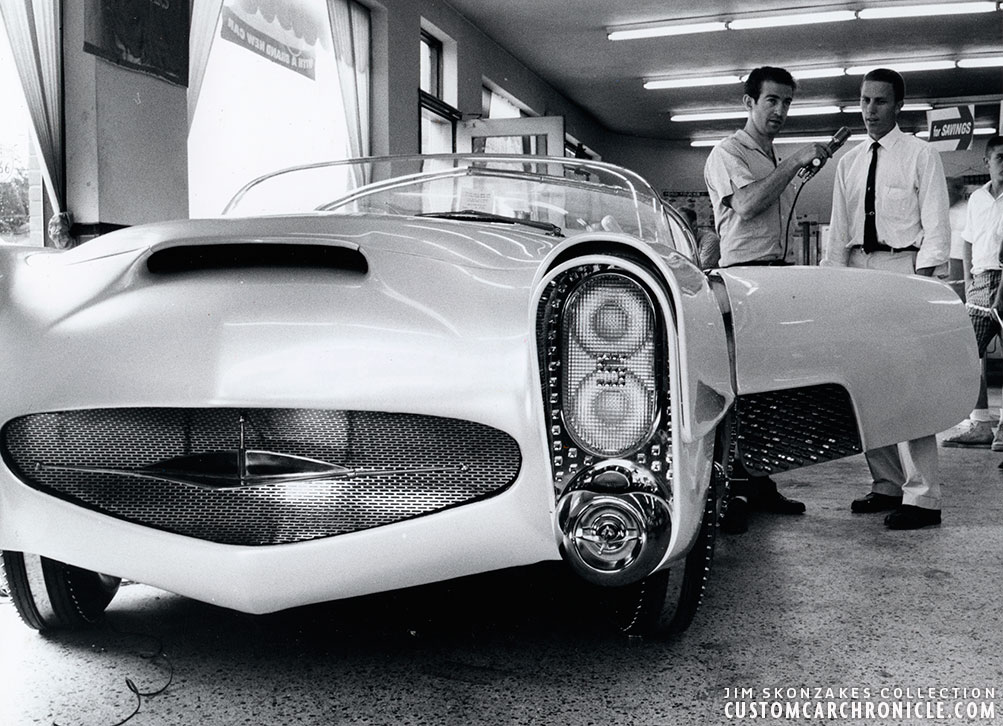 One of the things Jim often did when demonstrating the Golden Sahara II was let some people of the audience work the many features including the voice operated door openers. Notice the stainless steel band in the center of the tires tread.
One of the things Jim often did when demonstrating the Golden Sahara II was let some people of the audience work the many features including the voice operated door openers. Notice the stainless steel band in the center of the tires tread.
[divider]
 Jim demonstrating the GS II at a San Antonio dealer. When and where ever Jim was doing these demonstrations there was always a crowd. The beautiful painting on the wall was done by a very talented Mexican guy Jim knew.
Jim demonstrating the GS II at a San Antonio dealer. When and where ever Jim was doing these demonstrations there was always a crowd. The beautiful painting on the wall was done by a very talented Mexican guy Jim knew.
[divider]
Traveling across the US
After having showed the Golden Sahara I at many shows Jim realized there was some good money in touring his cars. He decided to take it all very serious, the only way for him. So he decided to create a customized hauler for the Golden Sahara that matched the car, and had a cargo bay that would be custom suited to fit the Golden Sahara and carry all the needed tools equipment etc that they would ever need while on the road. The cargo bay was designed in a way that once the GS-II was inside, Extensions of the truck frame would be raised and meet with the frame of the GS-II and would be raised further so that the wheels of the GS-II would be in the air. This made sure that whatever happened to the truck the GS would not hit the walls front, rear or sides. The Custom restyling on the cab was done by Bill DeCarr in California, but the cargo area was done close to Dayton Ohio.
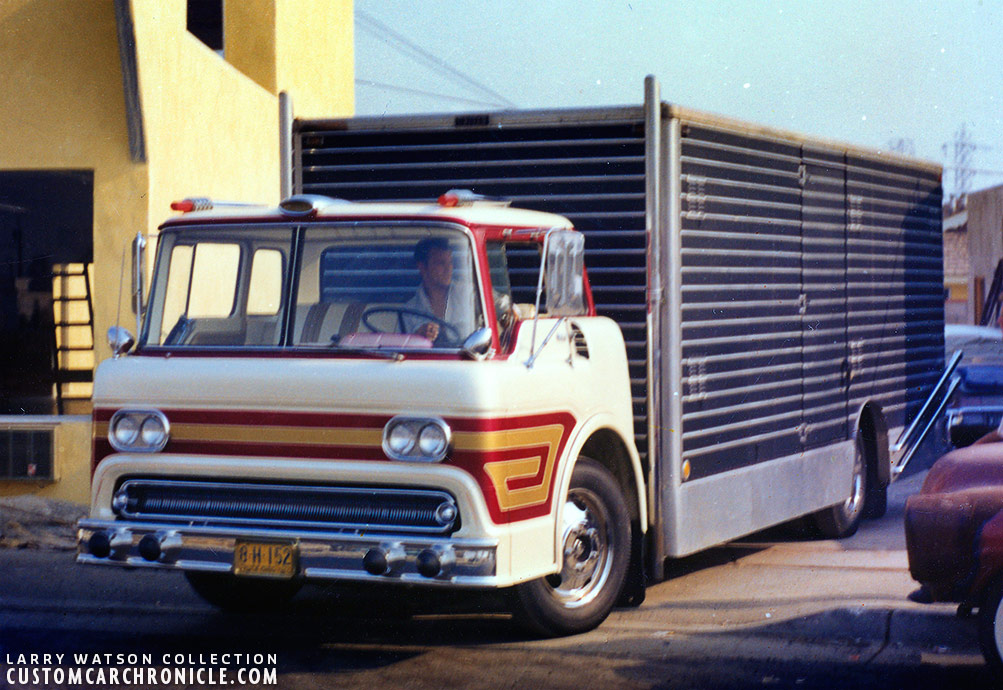 The first version of the Golden Sahara Hauler was restyled by Bill DeCarr and painted pearl white with gold ad candy red by Larry Watson. The GS Hauler can be seen here leaving the Larry Watson Bill DeCarr Artesia Blvd shop in Bellflower Ca.
The first version of the Golden Sahara Hauler was restyled by Bill DeCarr and painted pearl white with gold ad candy red by Larry Watson. The GS Hauler can be seen here leaving the Larry Watson Bill DeCarr Artesia Blvd shop in Bellflower Ca.
[divider]
 Later the car was further restyled and repainted metalflake gold and silver. The black and white photo shows the hauler with the special Kookie-T trailer, this is how the Golden Sahara and Kookie-T toured the US for many years. (Inset color photo from the Denny/Trent Knight Collection)
Later the car was further restyled and repainted metalflake gold and silver. The black and white photo shows the hauler with the special Kookie-T trailer, this is how the Golden Sahara and Kookie-T toured the US for many years. (Inset color photo from the Denny/Trent Knight Collection)
[divider]
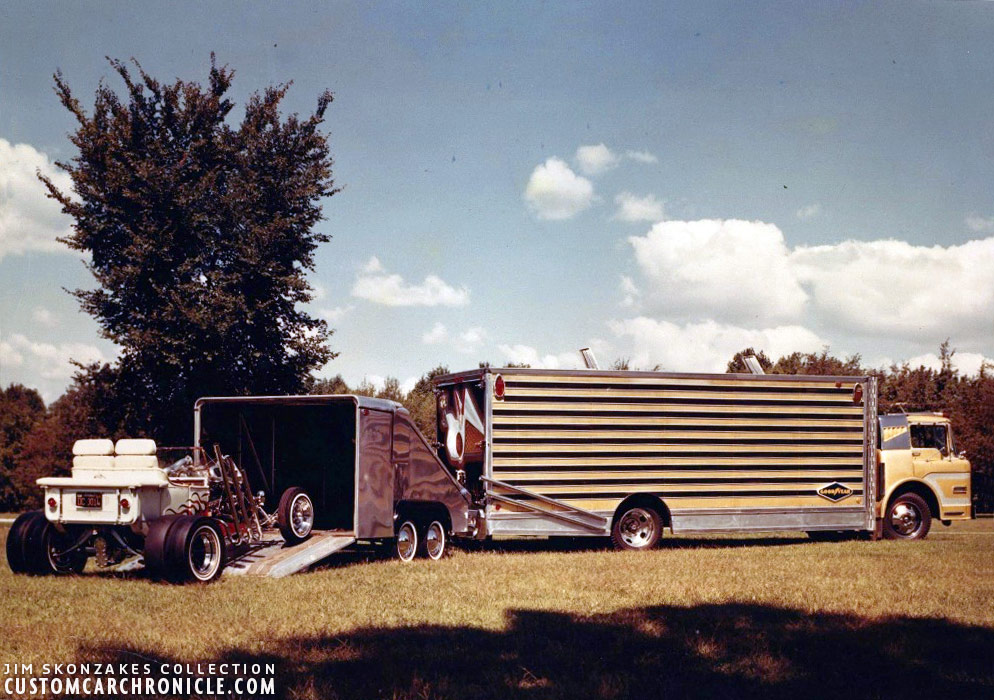 The Kookie T getting unloaded from the special trailer created by Don Mann at Creative Metals in New Carlisle, Ohio.
The Kookie T getting unloaded from the special trailer created by Don Mann at Creative Metals in New Carlisle, Ohio.
[divider]
 The Golden Sahara getting unloaded from the truck. The inset photo shows the car getting unloaded at Lake Mead.
The Golden Sahara getting unloaded from the truck. The inset photo shows the car getting unloaded at Lake Mead.
[divider]
Becoming World Famous
The Golden Sahara II made it into the Cinderfella movie because the movie prop manager of Paramount had seen the car in a Good Year magazine ad and liked the looks of it. He contacted Good-Year and they contacted Jim about it. When Jim called the movie prop manager, who was a super nice guy, he and the GS were at a car show in Denver Colorado. The movie prop manager asked if they could see the car in person. Sure no problem. After the show is over I will drive to the Paramount studio’s to show the car.
The prop manager explained that they needed the car for a movie kind of like the well known Cinderrella story, but then based around a guy. The car they had in mind would change into a bike and a chauffeur driving the car would be changed into a gold fish. And that for the car they needed a sort of magical futuristic car and they though the Golden Sahara might be the perfect car for them. When Jim arrived at the gates of the studio he got escorted to the office where the prop manager was having a meeting. Jim was introduced and asked to show the car. Jim asked if he could use the parking lot next to the building to unload the GS from the truck. Sure those are all our cars parked there and we can move them.
 Jim Street, on the right showing Jerry Lewis all the high tech features of the Golden Sahara II.
Jim Street, on the right showing Jerry Lewis all the high tech features of the Golden Sahara II.
[divider]
The parking lot was in between two studio’s and in one the Bonanza series was being filmed at the that moment. Tony Curtis was there as well. Jim opened the truck and was taking the ramps out. Ones he got into the car and started to back up a crowd of people started to gather around the Golden Sahara.
And soon after that the whole cast of Bonanza got out of the studio to look at the car. Jim had the car out of the truck but still on the ramp and figured he leave it there since there were to many people around it and he was afraid to damage it. It seemed like everybody at Paramount had stopped doing what they were doing to look at this amazing car. The movie Prop manager said that Jim could put the car back in the truck again and if he wanted to get inside with him. Inside he was asked to sign the contract. The GS-II was EXACTLY what they had in mind and needed for the movie. So Jim signed the contract. The shooting on the movie would start soon after that so the car had to stay at Paramount. Which would fit perfect with Jim’s other plans for the car.
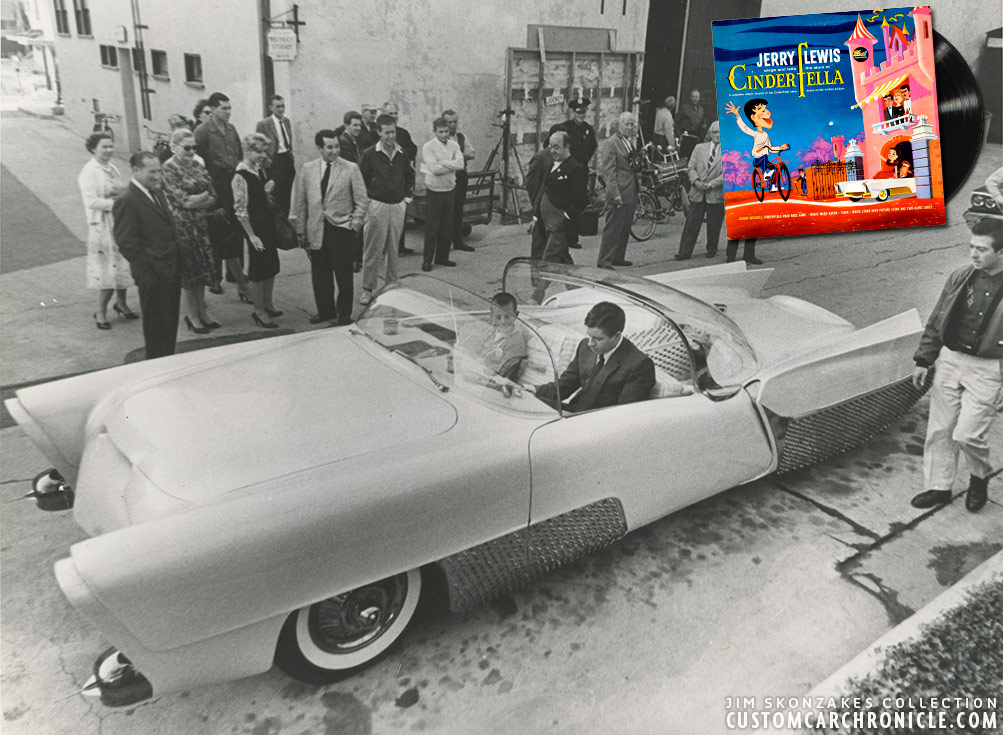 Jerry Lewis and a lucky kid in the GS-II at the Paramount Studios. Wherever Jim took the Golden Sahara, there was always a crowd.
Jerry Lewis and a lucky kid in the GS-II at the Paramount Studios. Wherever Jim took the Golden Sahara, there was always a crowd.
[divider]
[box_light]
Goofing around at the movie set
During the move shooting of Cinderfella Jim was pleasantly surprised that everybody, and especially the actors were goofing around all the time, joking and trying to pull pranks on everybody. So one time, when they were shooting close ups of Jerry Lewis in the Golden Sahara while on a big screen behind the car some moving images made it appear Jerry was driving the car, Jim came up with a great idea. The seats in the Golden Sahara had heavy duty massage units build into them. And they could, just as every other electronic feature, be remote controlled. So when the camera’s were running and Jerry doing his lines Jim, out of sight, starts the massage unit. Jerry stops acting, puts his head in the cushion, moans and completely relaxes… “I want this car” he yells. Guys at the set had warned Jim not to do it since he was not supposed to interfere with the actors, but Jim, stubborn as he was did it anyway, and Jerry loved it.
[/box_light]
 Jerry Lewis was very impressed with the Golden Sahara and used every opportunity to get in, and even drive it around at the movie studio.
Jerry Lewis was very impressed with the Golden Sahara and used every opportunity to get in, and even drive it around at the movie studio.
[divider]
Accident at the Movie Shoot
To be able to shoot the driving scenes of the Golden Sahara for the Cinderfella movie Hollywood Boulevard had been closed down partly for the public. The shooting took place at 2 o clock in the morning. After the shots were taken, the movie people told Jim to wait for his police escort to take the car back to where the Golden Sahara truck was parked. The escort bike was there, but nobody to drive it. While Jim was waiting for his police escort, the police at the road block on Hollywood Boulevard thought they could open the road to the public again. By then Jim’s motor-cycle cop escort had arrived but could not get his bike to start. Then all of the sudden Jim was hit in the drivers side by 1955 T-Bird. Jim heard the gold plated ornaments drop all over the street.
Jim jumped out of the Golden Sahara, and forgot he had just gotten back from the hospital and had metal clamps in his leg from surgery. The metal clamps ripped off, lots of pain, but Jim was just to upset to think about that right now. He could see the front hubcaps being damaged, some of the pearl paint was badly chipped and many of the buttons on the cove front panel were torn off. Since the motor-cycle cop could not get his bike to start Jim jumped into the GSII and chased the guy in the ’55 T-bird. When the guy had to stop for a red light Jim jumped out stumbled to the car, pulls the door open and punched the guy in the face, preventing him from getting away. Later the polices arrested the guy and Jim pressed charges against him at the police station. The Golden Sahara was needed for promotions while in California, so he asked if he could use the facilities from the Paramount studio’s. Jim’s GS hauler truck had every tool and supplies in it he needed, but he needed some space to get the damage fixed and the pearl white sprayed. The truck had a compressor, and Jim had brought paint guns, extra pearl paint, white base, and spare gold plated ornaments.
 Movie stills from the 1960 Paramount Pictures movie Cinderfella in which the Golden Sahara II stars next to Jerry Lewis. Gold painted actor Norman Leavit is the chauffeur in the close ups, but it was Jim Street who did the driving scenes in the movie.
Movie stills from the 1960 Paramount Pictures movie Cinderfella in which the Golden Sahara II stars next to Jerry Lewis. Gold painted actor Norman Leavit is the chauffeur in the close ups, but it was Jim Street who did the driving scenes in the movie.
[divider]
Once the movie shooting for Cinderfella was done with and the contract ended Jim was asked to keep the car for another month at Paramout studios. The car had left such an impact there that people from all over asked to see the car. The studio happily paid Jim an substantial amount of money for another month. “Not a problem,” Jim said.
After that month Jim drove the truck with the GSII inside back home to Dayton while on the road for quite some time, he was pulled over by a cop. “What did I do officer” Jim said knowing he did not do anything wrong. “are you mr Jim Street sir” the officer asked. “Yes I’m” Well here is a number you need to call! Paramout studio’s had another movie roll for the Golden Sahara and wanted Jim to come back. Remember, this was the time way before there were any cell phone’s but the connections Paramout had made the police cooperate in this. The new movie planned for the Golden Sahara to be in was going to be with Elvis Presley as lead actor. Although the movie never happened. Jim did drove back to the Movie Studio, and was introduced to Elvis Presley, who totally loved the Golden Sahara, and even tried to buy it from Jim.
The Cinderfella movie was shown world wide, and made the Golden Sahara II World Wide popular. Car enthusiasts outside of the US, who might have heard, or had read about the Golden Sahara, were now able to see it in color, and moving in the film footage.
The Golden Sahara II was also used for several TV commercials, both local as well as national. Walter Cronkite shot the Golden Sahara at Miami beach, and it was used in several local Ohio commercials. In 1962 Jim appeared with the car on the very popular TV show I’ve Got a Secret, which made a huge impact on a very wide audience. A YouTube clip of the I’ve Got a Secret can be viewed HERE. Another TV show appearance on YouTube can be seen HERE.
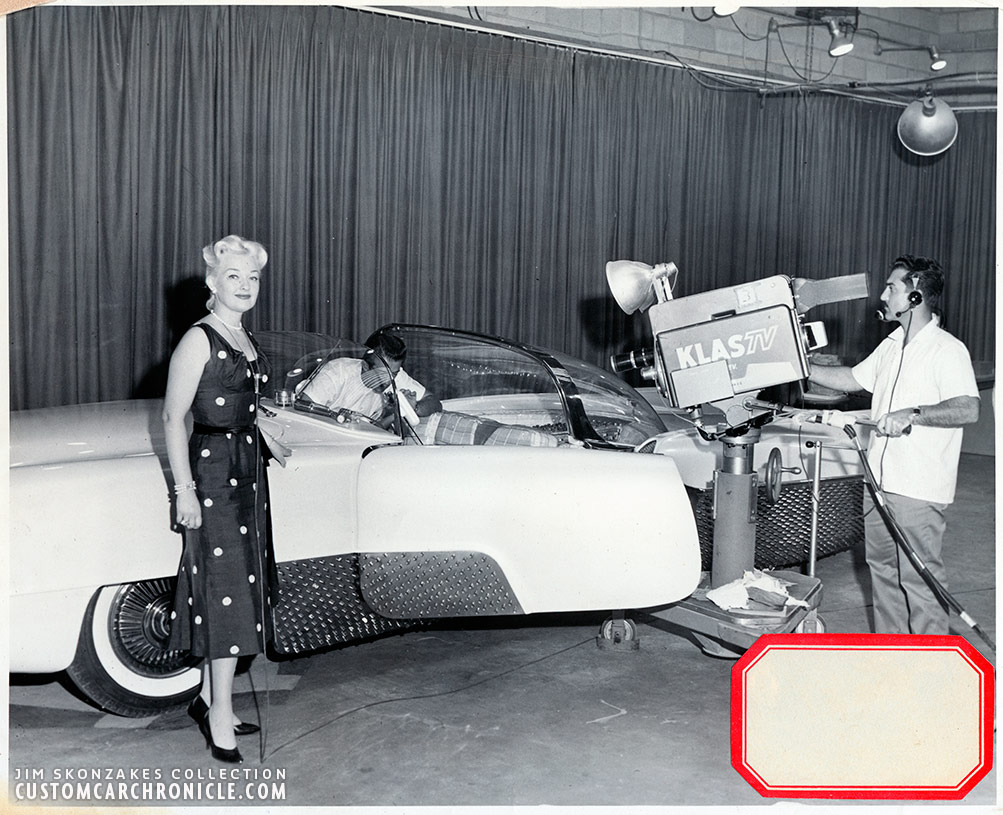 Jim demonstrating the Golden Sahara II early version at a local TV studio.
Jim demonstrating the Golden Sahara II early version at a local TV studio.
[divider]
 Jim demonstrating the latest Golden Sahara features for one of the many TV shows it appeared in.
Jim demonstrating the latest Golden Sahara features for one of the many TV shows it appeared in.
[divider]
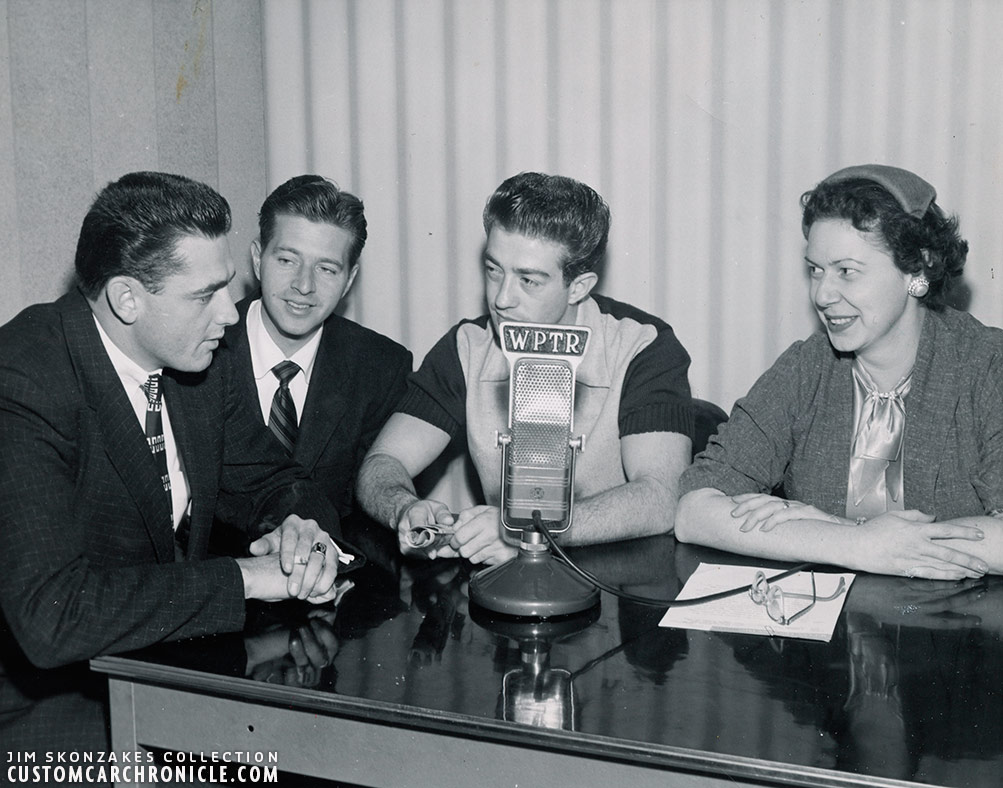 Radio interview for Jim Street about the Golden Sahara.
Radio interview for Jim Street about the Golden Sahara.
[divider]
 Jim Street and his Golden Sahara II as seen on a June 25, 1962 broadcast of I’ve Got a Secret.
Jim Street and his Golden Sahara II as seen on a June 25, 1962 broadcast of I’ve Got a Secret.
[divider]
 The Golden Sahara II appeared on magazine covers and was featured inside. It also appeared on the cover of several car show programs, helping to attract more visitors to the show.
The Golden Sahara II appeared on magazine covers and was featured inside. It also appeared on the cover of several car show programs, helping to attract more visitors to the show.
[divider]
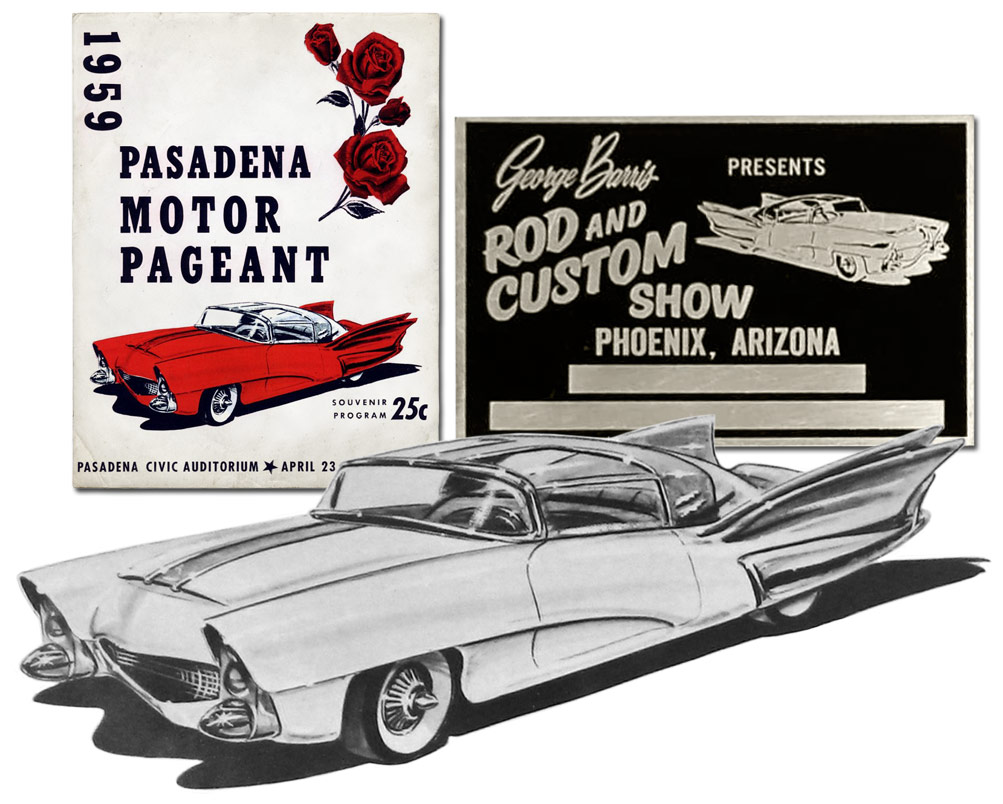 An illustration of a mix between the Golden Sahara I with GSII double finned rear fenders was used at several car shows and award plaques.
An illustration of a mix between the Golden Sahara I with GSII double finned rear fenders was used at several car shows and award plaques.
[divider]
 The Golden Sahara II appeared on at least two trading cards in the early 1960’s.
The Golden Sahara II appeared on at least two trading cards in the early 1960’s.
[divider]
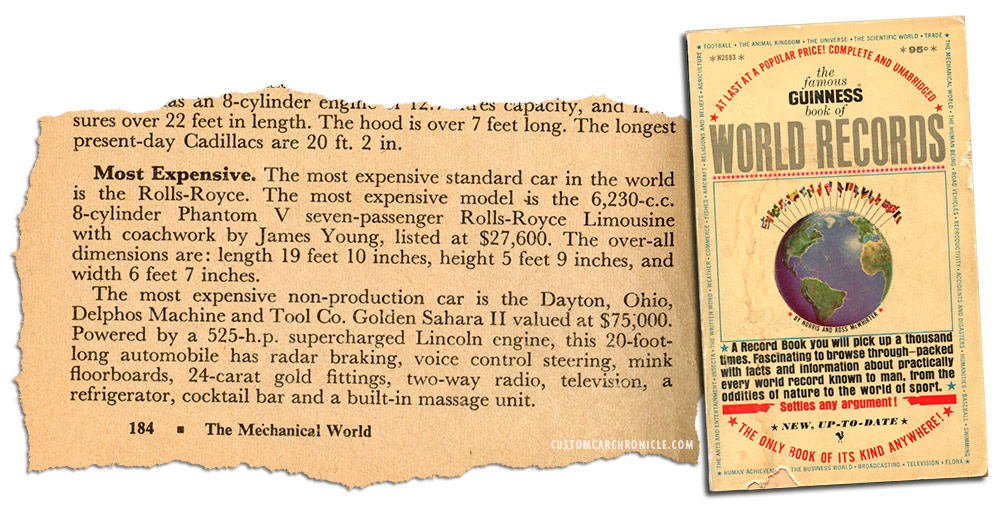 The Golden Sahara also made it into the Guinness World Records Book as the most expensive non-production car.
The Golden Sahara also made it into the Guinness World Records Book as the most expensive non-production car.
[divider]
Henry Meyer
Henry Meyer worked at the Delphos Machine Shop, but he also had his own shop. Jim and Henry became very close friends and their friendship lasted until Henry passed away in 1994. They worked on the Golden Sahara very closely and together came up with a huge amount of inventions they used on the car. Together with Henry Meyer Jim spend countless hours at the junkyard finding the right parts to create the Golden Sahara. Jim is a visionary and sees things with his on-board camera, as he says it. With Henry he had this special relation that he was able to tell him what he wanted, and Henry came up with the ideas how to create it. This was how they created the items on the Golden Sahara as the stick steering, the push button steering and many other special features. Jim met Henry for the first time in 1947, and have always remained friends.
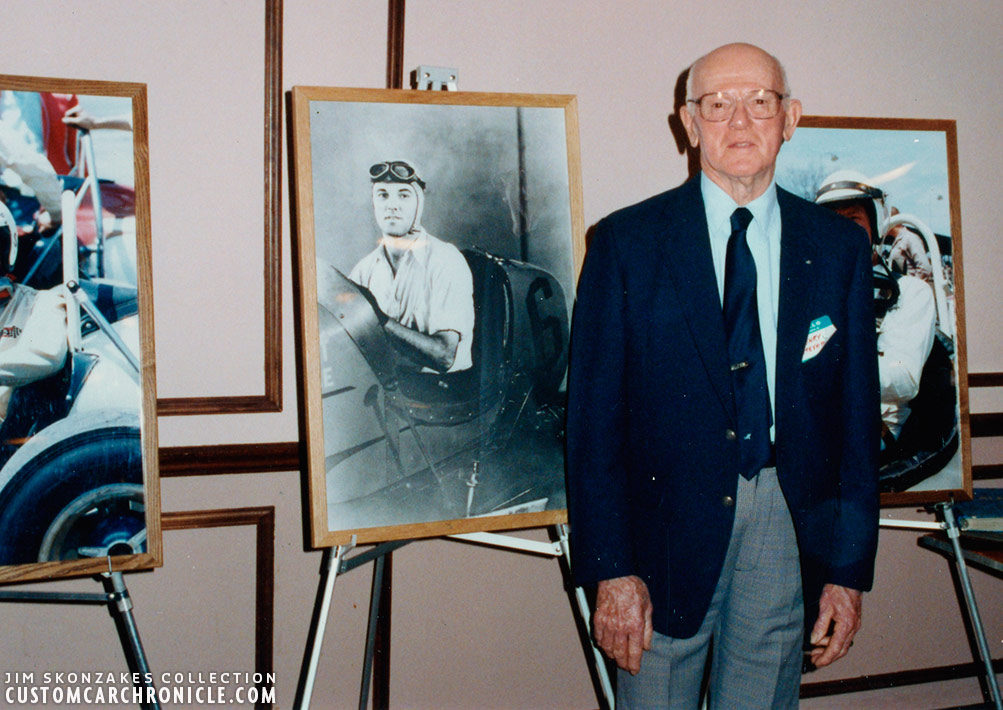 Henry J. Meyer, good friends with Jim Street from back in 1947, was the engineer behind many of the special features on the Golden Sahara. Henry was the guy that made sure it all worked.
Henry J. Meyer, good friends with Jim Street from back in 1947, was the engineer behind many of the special features on the Golden Sahara. Henry was the guy that made sure it all worked.
[divider]
Radar Security and Retiring the Golden Sahara
When Jim Street showed the Golden Sahara around the country during the 1960’s he had plenty of time to think about possible future updates, a Golden Sahara III. While he was making plans for the GSIII he also thought about ways to use the technology Henry Meyer and him had developed. One of the interesting techniques they used to have the car stop automatically when it was approaching objects was especially interesting. The system they used would detect any motions of living creatures even thru walls, and Jim figured that would be ideal for a burglar alarm. Jim went ahead and explored the possibilities to use the technique for security, a burgular security system. It turned out to be the perfect start for a state-of-the art movement security system.
In fact it was so good that Jim decided to start producing the security system, and build a complete business around the system. RADAR Security was born, and became a very successful security business in and around Dayton Ohio. The business grew fast, and would stay in business for the next 30 plus years with Jim leading it. Even though the business part of it was very nice, it did prevent Jim from creating the Golden Sahara III.
In 1966, the Radar Security. Business took up most of Jim’s time. The Golden Sahara II had been traveling the US for almost ten years and was in need of freshening up at the least. The car was not up to the ever evolving standards Jim had, and especially the wear on the car from all the traveling had become hard for Jim to look at. Since Jim spend most of his time at the Radar company he decided to retire it and store it at his climate controlled garage ,all wrapped up. Jim was asked multiple times to take out the GS and enter it at special event, but Jim knew the ones brilliant pearl white paint had turned golden brown, and the plating on many of the exterior parts needed to be redone.
 Jim Street behind his office in the Radar Security office building in the 1970’s. Notice the GSII, Kookie-T and GS Hauler photos on the wall behind him.
Jim Street behind his office in the Radar Security office building in the 1970’s. Notice the GSII, Kookie-T and GS Hauler photos on the wall behind him.
[divider]
So there was no way Jim would show the GS if it was not up to his high standards. In the last 10 years when I talked to Jim about the GS we often talked about restoration of the GS which Jim seriously considered from time to time, but always realized he just did not have the time which was occupied mostly with his passion for vintage wooden boats etc, and other car projects. The Golden Sahara Would remain in storage as how it was stored back in 1966 until Jim passed away on November 29th 2017 and was not uncovered until March, 2018, when it was photographed for the May, 2018 Jim Street Estate Auction at Mecum Indianapolis Auctions. Read more about the uncovering of the Golden Sahara and the Kookie-T in the CCC-Article.
Golden Sahara III
Jim had plans for a GSIII based on the current car. But this time it would become an amphibious vehicle. Boat and car in one, based on the same car… perhaps, or perhaps all new. Jim often mentioned that especially the interior would be something really special, he has some great plans for that in his head. Many of those plans were discussed with Henry Meyer and both were looking forward to start on the project which was about 30 years ago from now. But since Jim was in the 24-7 business of his Radar Security he never found the time to start the project. Henry always regretted that since he really looked forward to start working on the car that could be used both on land and in the water. And knowing what both people could create this would have been one spectacular vehicle.
 The Golden Sahara in March 2018 after the covers had been removed for the first time in decades.
The Golden Sahara in March 2018 after the covers had been removed for the first time in decades.
[divider]
(This article is made possible by)
![]()

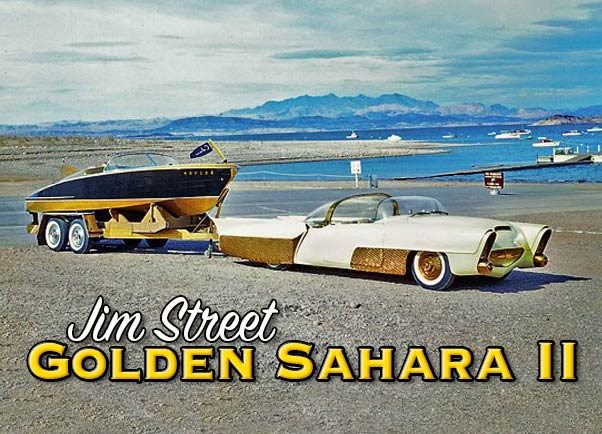
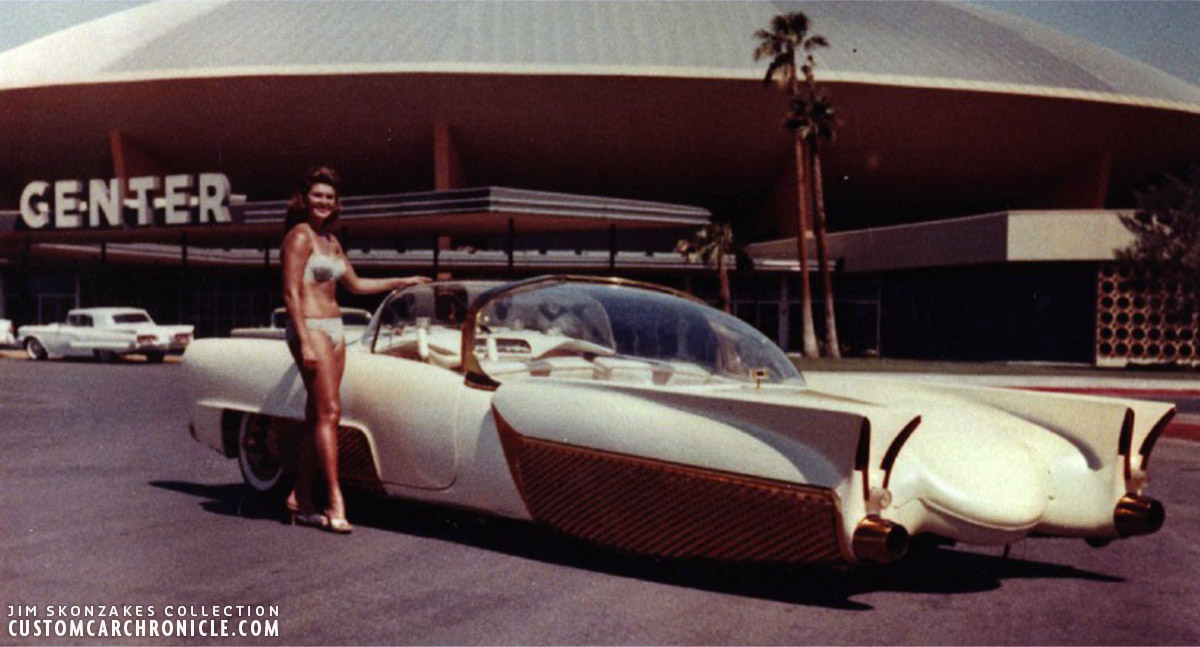

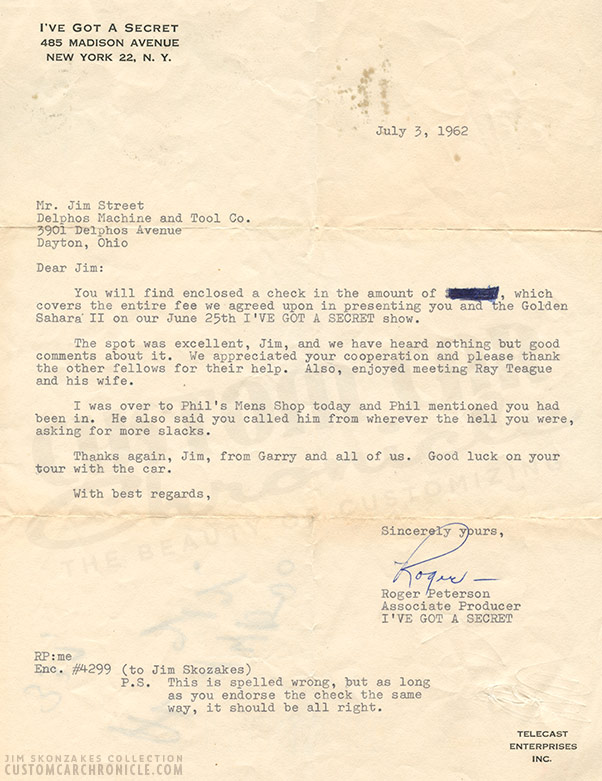
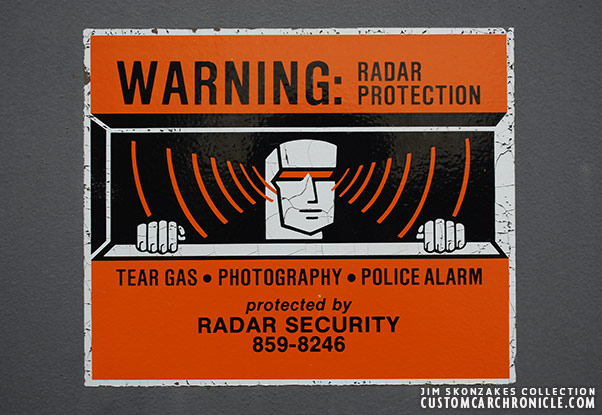




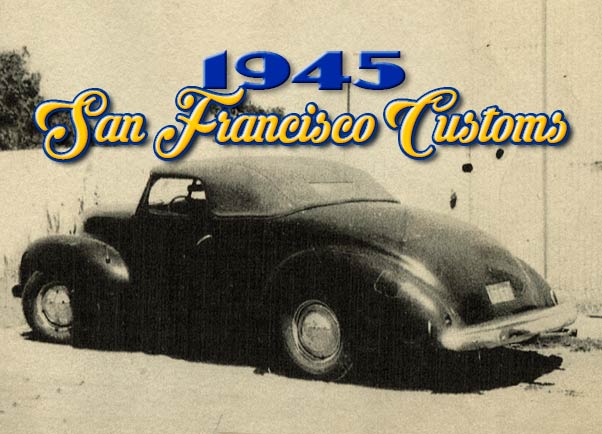
Thank you Rik very informative …………….
So much to learn about this great Custom !
Did the GS transporter truck survive as well? It would be amazing to see them both together.
Thanks as always Rik.
Torchie